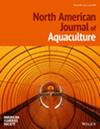冠突伪尾柱虫稚鱼的细菌群落以及稚鱼作为向鱼类幼体提供早期益生菌的载体的潜力
IF 1.3
4区 农林科学
Q3 FISHERIES
引用次数: 0
摘要
方法为了研究冠突伪尾柱虫稚虫的细菌群落并探索稚虫作为益生菌载体的潜在用途,成体桡足类在饲养过程中添加或不添加益生菌(芽孢杆菌属和乳酸杆菌属)。两种处理中的桡足类稚虫均富含益生菌或不富含益生菌,从而形成四种处理:对照饲养和不富含益生菌处理、对照饲养和富含益生菌处理、富含益生菌饲养和不富含益生菌处理以及富含益生菌饲养和富含益生菌处理。对 16S 核糖体 RNA 基因进行了新一代测序分析。0%)和类杆菌科(27.6 ± 6.7%);在这些门类中,数量最多的是罗氏菌目(21.8 ± 2.0%)、黄杆菌科(13.5 ± 9.4%)、嗜壳菌目(9.7 ± 1.8%)、异单胞菌目(9.5 ± 4.0%)和伯克氏菌目(3.8 ± 0.8%)。弧菌属和假单胞菌属等机会致病菌属的相对丰度非常低(<1.2%),这表明 P. crassirostris 呐栉水母可被视为一种安全的微生物活饲料。此外,由于益生菌能成功附着在桡足类的外骨骼上,因此冠突伪尾柱虫稚虫是输送益生菌的良好载体。冠突伪尾柱虫稚虫体内的芽孢杆菌数量是乳酸杆菌数量的 5-6 倍。用益生菌饲养的稚鱼和富含益生菌的稚鱼体内益生菌相对丰度的平均值最高(芽孢杆菌属 41 ± 6.0%,乳酸杆菌属 6.0 ± 3.0%)。本文章由计算机程序翻译,如有差异,请以英文原文为准。
Bacterial community of Parvocalanus crassirostris nauplii and the potential of nauplii as a vector for early probiotic supply to fish larvae
ObjectiveThe copepod Parvocalanus crassirostris has recently increased its use as live food in marine fish hatcheries.MethodsTo investigate the bacterial community of P. crassirostris nauplii and explore the potential use of nauplii as a vector for probiotics, adult copepods were reared with or without a probiotic consortium (Bacillus spp. and Lactobacillus spp.). Nauplii from both treatments were either enriched with probiotics or not, resulting in four treatments: control rearing and nonenriched, control rearing and probiotic enriched, probiotic rearing and nonenriched, and probiotic rearing probiotic enriched. A next‐generation sequencing analysis of the 16S ribosomal RNA gene was performed.ResultThe bacterial community of nauplii without probiotics was dominated by the phyla Proteobacteria (mean ± standard deviation = 51.5 ± 8.0%) and Bacteroidetes (27.6 ± 6.7%); from these phyla, the most abundant orders were Rhodobacterales (21.8 ± 2.0%), Flavobacteriales (13.5 ± 9.4%), Chitinophagales (9.7 ± 1.8%), Alteromonadales (9.5 ± 4.0%), and Burkholderiales (3.8 ± 0.8%). Opportunistic pathogenic bacterial genera, such as Vibrio spp. and Pseudomonas spp., were detected at very low relative abundances (<1.2%), indicating that P. crassirostris nauplii could be considered a safe microbiological live feed. Furthermore, P. crassirostris nauplii were a good vector for probiotics delivery, as the adhesion of probiotics on the copepod exoskeleton was successful. Bacillus spp. abundance was 5–6× greater than the abundance of Lactobacillus spp. in P. crassirostris nauplii. The highest mean values of probiotics relative abundance (Bacillus spp. 41 ± 6.0%, Lactobacillus spp. 6.0 ± 3.0%) were observed in nauplii that were reared with probiotics and also enriched with probiotics.ConclusionParvocalanus crassirostris nauplii stages I–II appear to be good vectors to provide probiotics to first‐feeding fish larvae.
求助全文
通过发布文献求助,成功后即可免费获取论文全文。
去求助
来源期刊
CiteScore
2.50
自引率
0.00%
发文量
46
审稿时长
18-36 weeks
期刊介绍:
The North American Journal of Aquaculture publishes papers on new research and practical experience in all areas of intensive and extensive fish culture. Topics include broodstock selection and spawning, nutrition and feeding, health and water quality, facilities and production technology, and the management of ponds, pens, and raceways.
The journal will consider papers dealing with ways to improve the husbandry of any aquatic species—marine or freshwater, vertebrate or invertebrate—raised for commercial, scientific, recreational, enhancement, or restoration purposes that may be of interest to practitioners in North America. Its scope includes both basic and applied science, but applied scientific endeavors—including practical experiences, descriptive studies, and other nontraditional, but pertinent works—are emphasized.

 求助内容:
求助内容: 应助结果提醒方式:
应助结果提醒方式:


